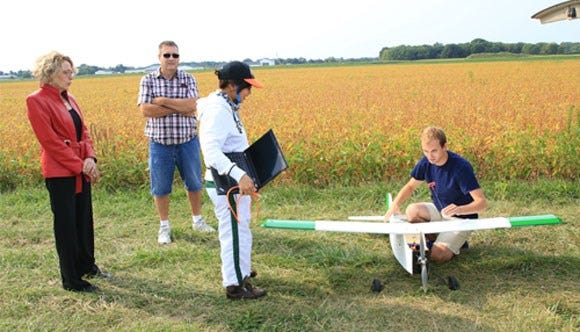Center to Add Drones, Apps, Big Data to Farmers’ Arsenal
 A Purdue student prepares a UAS for flight at the university’s Agronomy Center for Research and Education.
A Purdue student prepares a UAS for flight at the university’s Agronomy Center for Research and Education.
Subscriber Benefit
As a subscriber you can listen to articles at work, in the car, or while you work out. Subscribe NowWhile it may seem surprising to some, farmers are among the earliest adopters of technology, say Indiana agricultural leaders. And that’s why drones will soon by flying over 1,500 acres of crops in West Lafayette at Purdue University’s new automated plant phenotyping facility. Unmanned Aerial Vehicles (UAVs) are among many emerging tools that will be studied at the research center to satiate Hoosier farmers hungry for cutting-edge technology.
Purdue agriculture leaders describe phenotyping as the next wave of innovation in the industry. While plant genetics are now well understood—researchers have a solid grasp on the DNA of every crop—there’s less clarity about how certain genetics translate into plants’ performance in the field.
“In different field conditions, [DNA] expresses itself differently,” says Purdue College of Agriculture Senior Associate Dean for Research and Faculty Affairs Dr. Karen Plaut. “Our weakness is understanding how the genetic information translates to the physical information of what the plant looks like.”
To get a better grasp on this, researchers rely on phenotyping, which is studying the physical characteristics of plants—height, leaves’ shape, even the exact number of kernels on a single ear of corn.
“If you go into a cornfield to measure the characteristics of every single plant, that’s difficult to do unless you put some automation behind it,” says Plaut. “Automation uses various tools; one of them people have heard of is UAVs that can fly across the field and take visual representations of every single plant. We also have ground equipment that can take measurements of those plants.”
Investigating the entire spectrum of these new technologies will be the focus of the plant phenotyping facility. For example, Plaut says labs will house imaging equipment that can count the exact number of rows and kernels on an ear of corn, which is currently done by hand: “you can imagine how difficult that is when you’re talking about thousands of ears of corn.”
Touted as the only center of its kind at a U.S. university, it’s scheduled to open in the spring at Purdue’s Agronomy Center for Research and Education. The plant sciences project is part of Purdue Moves, a series of university initiatives announced by President Mitch Daniels in 2013.
The $10 million building, which will focus mostly on corn and soybeans, will hold advanced equipment worth an additional $5 million. The Indiana Soybean Alliance and Indiana Corn Marketing Council are providing $4 million to support the project, the organizations’ biggest ever collective investment. Chief Executive Officer of both entities Jane Ade Stevens says, while farmers are excited about the massive amount of information that can be collected in their fields, they’re not quite sure what to do with it yet.
“UAVs, big data—this is all still very, very new,” says Stevens. “I think we’re at the beginning of the cycle; it’s a hot topic right now, but we haven’t quite yet figured out how a farmer in his day-to-day practice is going to use it easily. That’s part of what we hope this facility will do—get a handle on how we really make these applications usable for farmers.”
The facility will unite Purdue’s College of Engineering, Department of Computer Science and School of Aviation and Transportation Technology; students and researchers will use team labs to build drones, develop new apps and find new ways to analyze data. Information collected from high-tech equipment in the air, on the ground and under the soil will be sent via fiber-optic cable to Purdue’s high-performance computing facilities.
“We want to figure out, for example, how to grow plants that need less water; water will be a limiting factor for generations to come,” says Stevens. “This center will help us get closer to those answers—how do we protect and enhance our natural resources with our corn and soybean production systems?”
Center leaders say drought stress, nutrient uptake and flooding response are just a few environmental challenges farmers face every day. While farmers can’t control Mother Nature, the facility aims to help them harness the power of information to have bumper crops—even when conditions are less than ideal.
“It’s the next level of high-tech science for farming and agriculture,” says Stevens. “Our kids and grandkids are going to be highly-effective, efficient farmers making the environment a better place. And that’s very exciting.”
Plaut, who has been an ag-related educator her entire career, says she never dreamed drones would be on the farm.
Plaut says automated phenotyping enhances what agriculture can do for the environment.
Stevens says the facility will help Hoosier corn and soybean farmers flex their muscle in new markets.
